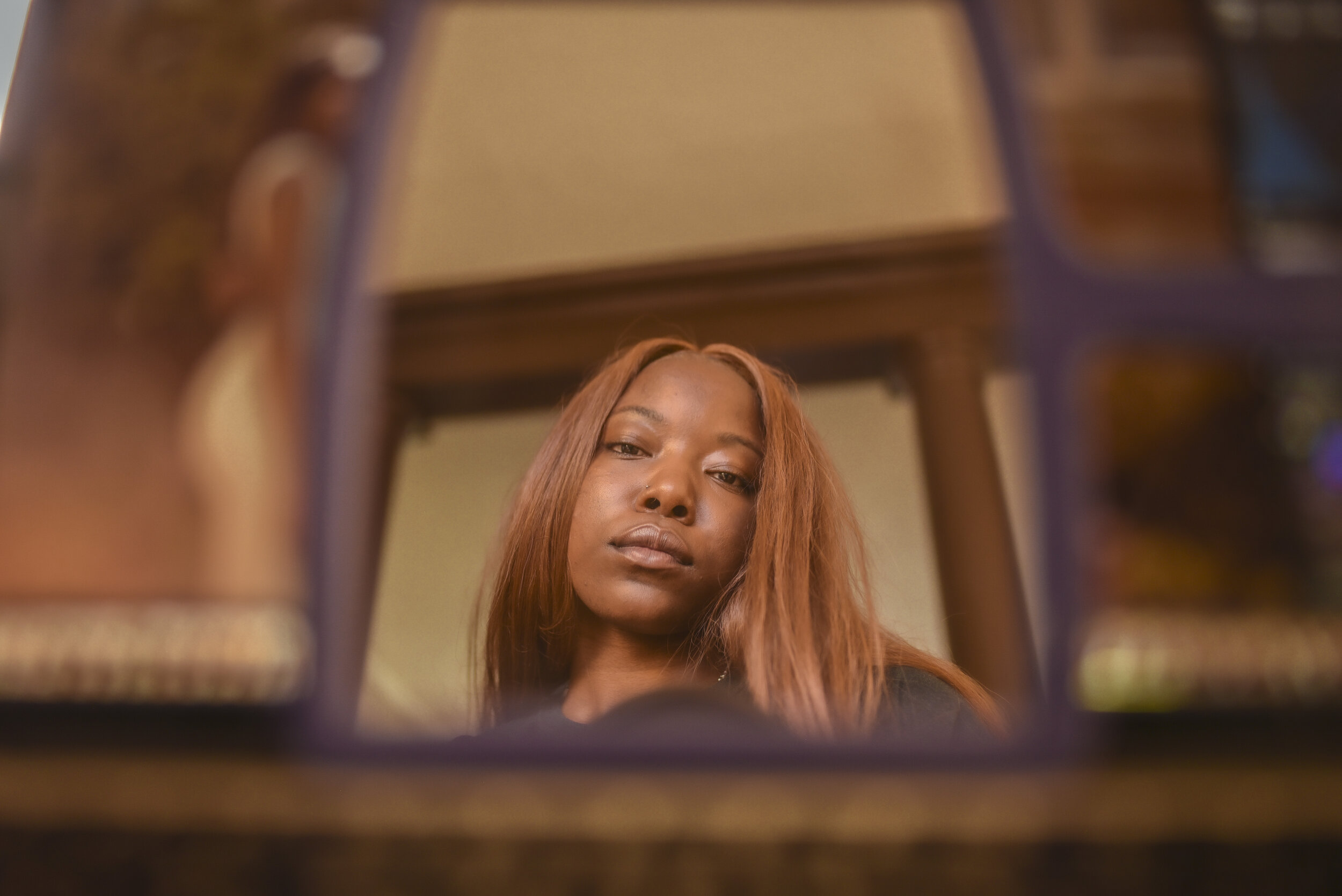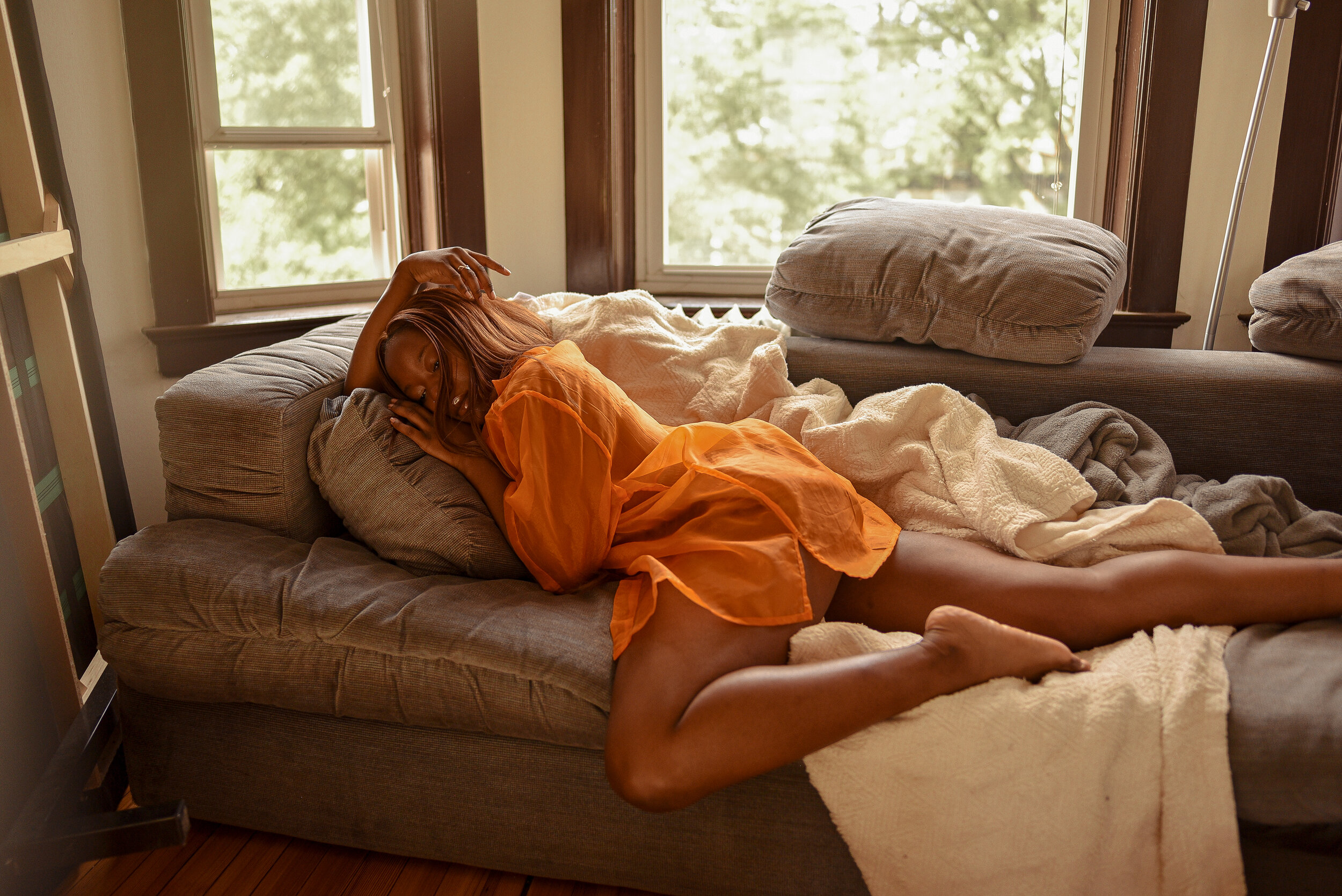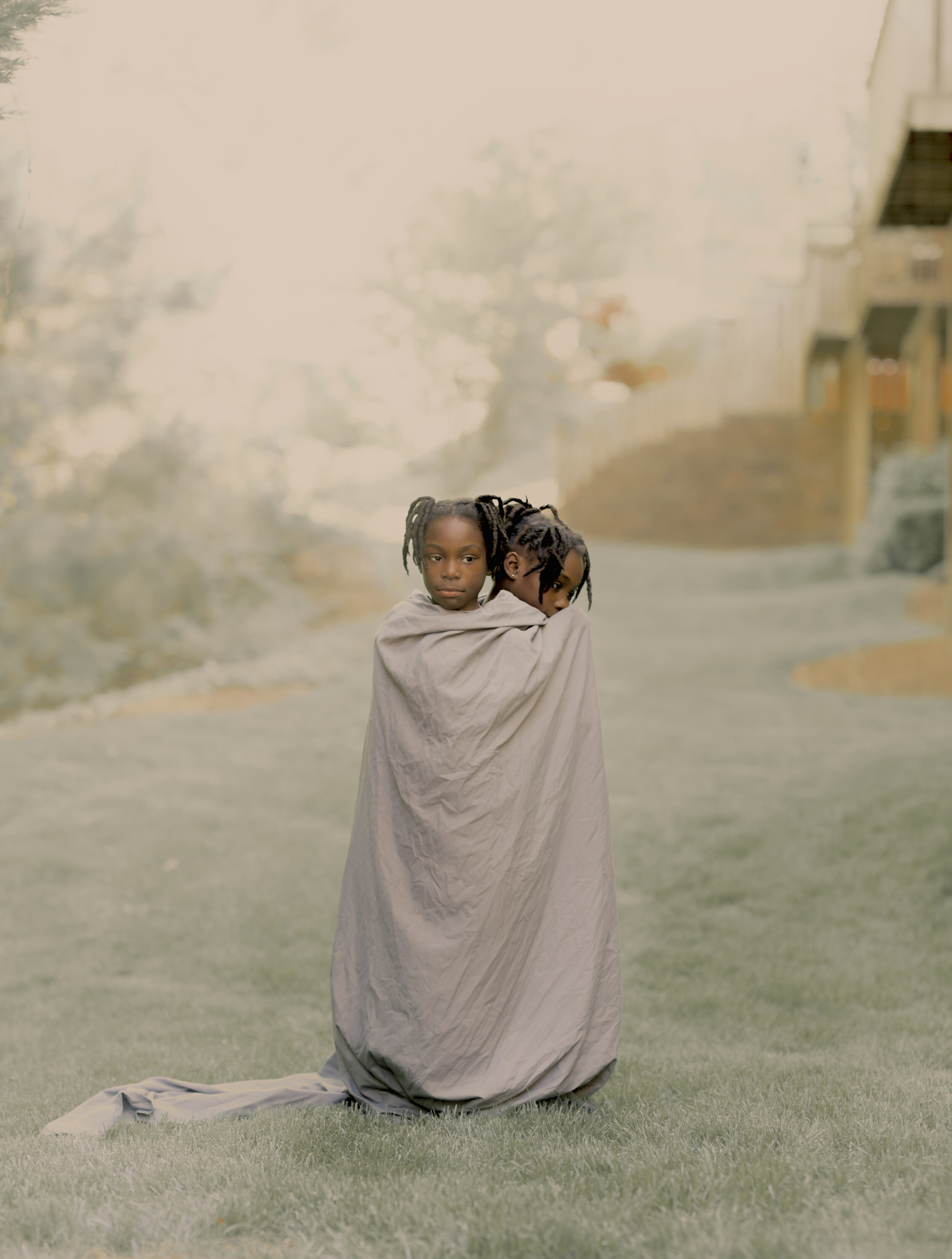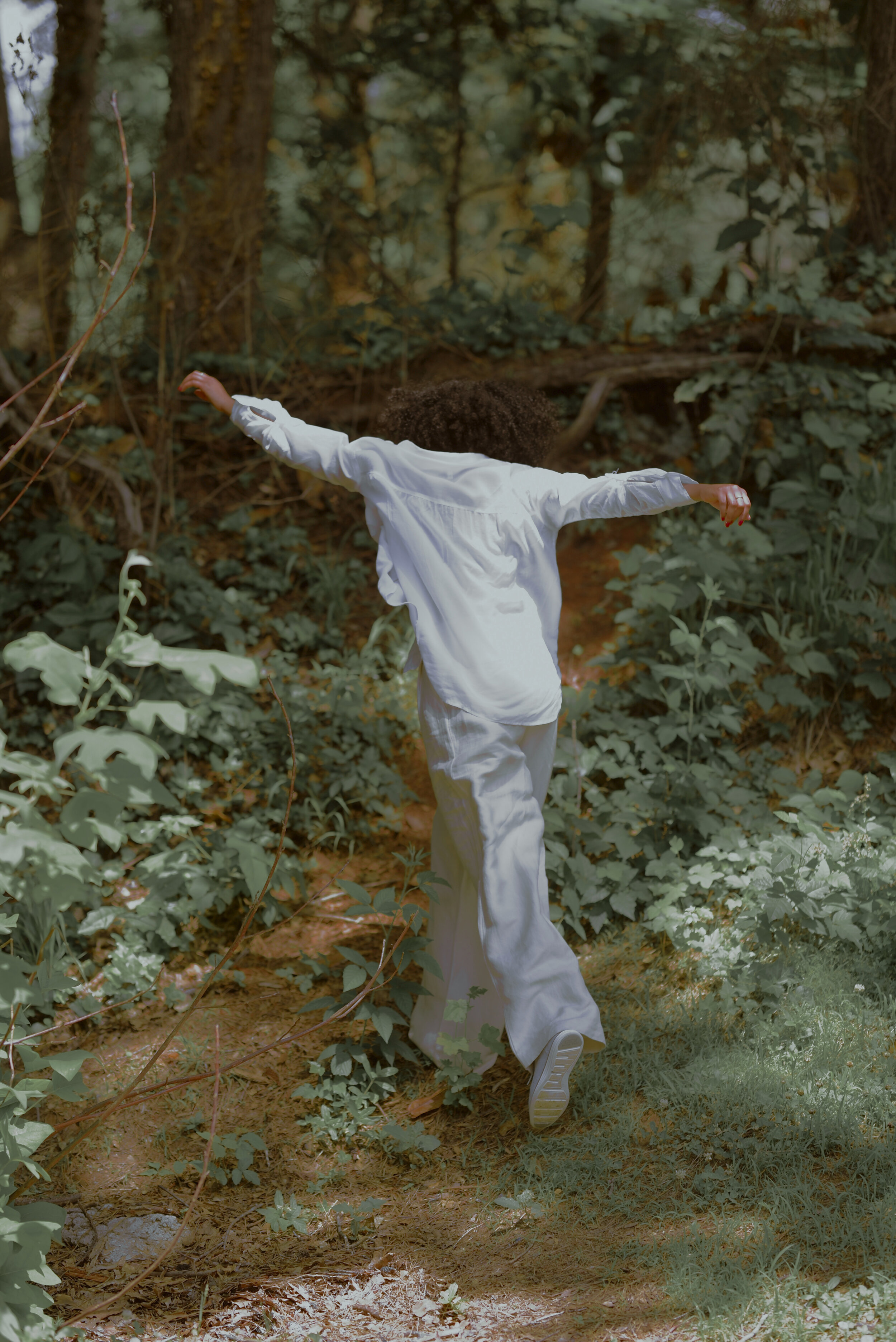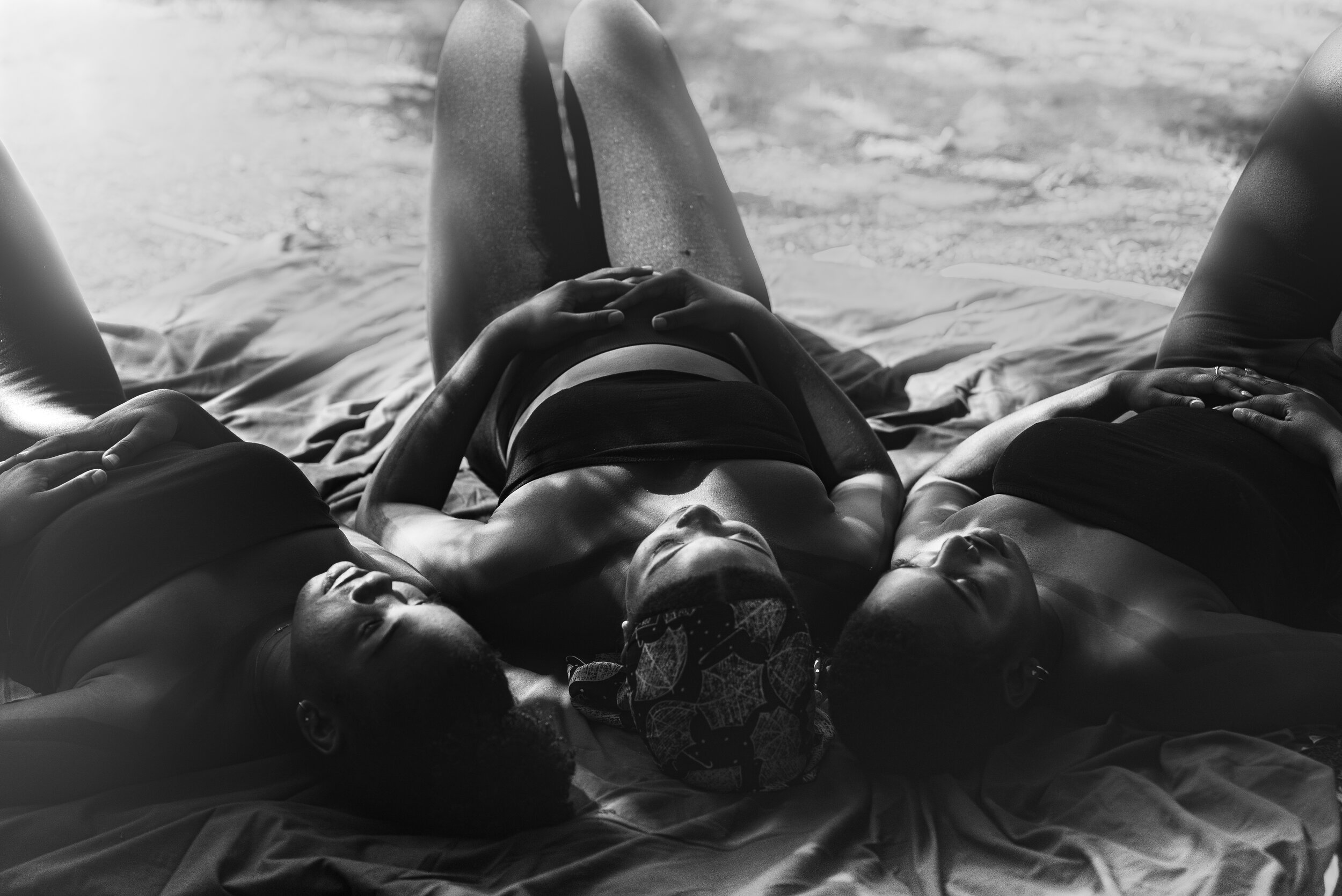Sydney Holmes, Photographer
by Mariko Rooks
So I've been taking pictures for probably since I was about 11. My father was a professional photographer and did, you know, like church events, sporting events, those types of things, proms. And so I just grew up with a camera in my face and I hated that [laughs]. I initially started off probably for my first five or so years, like, just refusing to take pictures of people. I would take pictures of landscapes and food and like, you know, if we traveled on a road trip I would take pictures there. But I was always kind of scared of taking pictures of people, of what they would look like, should look like. I wasn't sure how to approach that. And so I didn't really start doing portraiture until I was in, like, high school, where I started doing my first paid jobs with an old camera that my dad helped me afford.
Once I got a much better camera, I kind of opened myself up to the possibility of using photography just as a more creative outlet. I started doing a lot of self-portraiture primarily, so I would kind of sit in my room for hours and hours on end. I noticed I would do it whenever I was stressed or anxious about something. I used it definitely as a coping mechanism for mental health struggles in high school, which I wasn't able to articulate I think until after the fact. I think I enjoyed the freedom of being able to just create something from nothing. That's something that's not unique to photography, it's like, I guess, a pretty common theme of the arts. It's just the power of being able to create something that was not there before and that you know is uniquely yours, and something that's original and something that you have complete agency in life over. I started doing that, but I would never share that with anyone. I kept it under lock and key. They were really precious to me.
“
I think I enjoyed the freedom of being able to just create something from nothing.”
Then I started getting more comfortable taking pictures of people. I wasn't really doing them for paid purposes, I would always just be doing it kind of for documentary purposes. I didn't kind of translate that creative side of it, into, you know, having other people sitting in front of my lens other than myself. I really started exploring that when I got to college and when I would go home for breaks when I was in college. You know, friends are always able and willing to get their pictures taken and be involved in fun creative stuff, so I used to just use a lot of my friends. I tried to stage things and use props and have different lighting setups, and I never knew what I wanted to do with the photos, I just knew I wanted to make the photos. So for a long time I had no real intention of sharing. That was something I was completely closed off to for a long time, because I think I was used to making photography just a way for me to understand myself more. That was always kind of my goal, so I didn't really see the value in sharing it. Once I got to college and did more things on the paid side, I also started to invest more time into taking pictures for the sake of being able to portray something meaningful about my identity and the identities I share with a lot of other people on this campus, my friends or otherwise. So then Black womanhood became just a central thing, and I centered it actively.
Before I recognized my tendency to only want Black subjects in front of my lens I just knew there were already photographers out there shooting purely white models and that I wanted no part of that. That was not really interesting to me. Seeing that, seeing Black forms, I just wanted to make sure that I was doing things differently with photography than what you're used to seeing on magazines and on TV and in movies, and all of the things in the media. I think the summer of 2018 was kind of like an awakening summer for me, and I just really pumped a lot of creative energy into designing shoots with people and having kind of a start-to-finish directorial role for the photo shoots that I would do. I would be telling people, “Okay, wear this kind of color scheme, this kind of outfit.” I would have locations I wanted to shoot at. I think that was a very freeing experience for me to be able to include other people in something. We were all kind of building this experience together and that felt central to my work. It felt necessary to make sure that whoever was in front of my camera, especially as a Black woman, that I was honoring their vision for themselves and how they wanted to be portrayed. I always wanted it to be a two-way street. I wanted my shoots to be co-constructed always, like where I’m implementing my vision but whoever's in front of my camera also has a chance to bring what they want to bring. I think that's something that is still very central to me. Those are the things that keep me going, that energize me— being able to play around with color and just create something that creates space for other people to just enjoy their existence. I think that's very important, that I can portray something and have that be legible to other people who can look at and then enjoy the experience of the picture, of engaging with a picture. That's always been very important to me.
“
It felt necessary to make sure that whoever was in front of my camera, especially as a Black woman, that I was honoring their vision for themselves...”
I never want to claim authorship over a narrative just, you know, because of the power dynamics of that have already been reproduced so many times. The history of photography is so brutal. I refuse to be like upholding the original vision. People would take pictures and go out to the “world,” you know, the continent of Africa and say, “Oh, look at what we captured, look at these pictures we've taken that clearly say something so objective and so true about the people that we are taking these pictures of!” And it was unfortunately really negative and was used so easily to contestify slavery and so many other things. So knowing that history is like something that you can't forget when you're just thinking about the power dynamics of the camera since its inception.
I decided to change my major to Photography last semester, because I decided to actually pursue photography 100%. I knew it was always going to be something that I did as a passion, something that I could do very important things with. But career-wise I was not set on that being, like, “it” until I felt like everything I had done and everything I was always doing was leading me back to photography in some way. I just decided to listen to my guts. Now that I'm doing work now for the purpose of sharing, it's definitely a different experience and a different process for me. I think the initial hard part was not really being sure what I would need to change about my work and about my process when I'm aware that there will be an audience, that it’s for an audience. Because that was never my intention beforehand, it was always just for the people I was making work with, it was for them. So having my work open to being consumed and engaged with by other people, other non-Black audiences, people who are looking in who don't really understand the experiences of Black women— to open that up was definitely initially hard because I had to fight the urge to change my subject matter and do something else that I thought would be easier to understand. I feel like my work really strengthened because I decided to just stick with what I do well and the subject matter that means the most to me, that I feel like I can say things with. That's when I made some work that I was actually finally pretty proud of to show something that I felt, something that was complex, that spoke to Black womanhood in a necessary way. I'm trying to honor that work in whatever way I can.
I think that stems from my own personal experience growing up. I went to predominantly private schools until I was in middle school and they were predominantly white private schools, and so there were a lot of things I felt I had to explain all the time. Just about myself and about who I am, and things that are important to me, as, you know, as a woman of color, as a Black woman, that my peers never really got. And I think despite maybe not feeling like I was always understood by people, I always made it a point to honor that I was a very complex person and there was no way that I would allow people to turn a blind eye to that. I think it's very easy to take the Black woman and collapse that experience into what you've heard in music or what you see in movies. These kinds of one-dimensional characters are, of course, very stereotypical and not true to real life, and offer no real insight into the everyday, individualistic experience of a Black woman. And so always keeping that in mind, that there's so much complexity in Black womanhood, that’s something not explored enough, just on screen or really in any form of digital media or in the art world.
I think there are so many sides to Black womanhood. I think I've always felt that I've been a complex person emotionally, and knowing that every Black woman everywhere has the same emotional complexities as I do, I’ve tried to figure out a way for people to look at and see and appreciate them. I think that’s been the cross that I have taken up. Because it's one thing to be able to make beautiful work, and I've always appreciated that that’s something I can do. I can make a beautiful picture of a Black woman, but I think I've always also wanted it not just to be that. I think Black beauty is, of course, a necessary thing to portray, to see Black happiness, but also, you know, sometimes Black sadness, Black mental health struggles, Black identity crises, all these things that tend to happen just as part of the experience of growing up as a Black woman, as a woman of color, as a Black person. So I think that is really something that I feel is driving my work now, to really be able to show just a range of Black emotion.
“I think Black beauty is, of course, a necessary thing to portray… but also, you know, sometimes Black sadness, Black mental health struggles, Black identity crises…”
Something that I hold on to when I'm shooting or after I've taken a picture is that I want there to be an awareness of a viewer. I want there to be an awareness of this is me seeing things how I see things, this is one perspective. I always want something to kind of remind the person engaging with the photo that they are seeing through something. Whether that's through your own life experiences, your own biases, or seeing through my vision, you're seeing through whatever I've got in front of the frame, if it’s a piece of tulle... all of these things cloud the frame in some way. I always want there to be an awareness that you are seeing through something. You're not just looking through something in an objective, flat way. I think that classically, the allure of photography is that it feels like you're a window into the world, that you are seeing things as they are rather than from particular point in time: one particular stance, one particular day, and one particular second from the hands of particular person holding the camera. Whatever I can do to make that obvious in the frame, that’s what I’m keeping in my mind.
I think I will always want the elements to be in conversations with one another rather than just waiting to be consumed by whoever is looking at the photo. I've tried to play around with different lenses, like, just different focal lengths in my lenses in my tool kit I always have a lens that I can use to isolate my subject from the background and just have them kind of be really like central in the frame, where you can see details of their face, of their hair, just textures come out more. And then I also make sure that I have a lens where I can capture a context. Broader environmental interactions, I think, are also necessary to kind of fill in any given story. I always make sure that I have my tulle cloth on me. I'm always making sure that I'm playing with layering things in the frame so I think that process has also just been integral to my work as a whole because, you know… complexity, layers.
I think my editing style has evolved over time to be a very central part of my work too, and a very noticeable part of my work. I'm very conscious of color and very drawn to reds and blues and greens. I love just those colors together, in conversation with Black skin. It just does something so different and so powerful for me. So I've never kind of let those elements go from my work. My editing style has always been trying to figure out ways that the skin can speak to something or can be in conversation with other things in the frame, whether that's color or textures. I've never wanted it to kind of be kind of a passive character in the story, but I also don't always want it to be the most obvious thing. I don't want it to be about skin either. So I think just trying to maintain a balance between having some sort of emotional interplay coming from the colors that I'm using but having the physicality of knowing that this is skin and this is a very particular color of skin, whether it's in the sunlight or in the shade or some leaves or whatever it may be.
I used to be kind of against staging things, but then I kind of wrapped my head around the fact that everything in the frame is constructed. There’s always something that’s left out, there's always something that is centered, there's something that you're focusing on, there something that you're not focusing on, so in that sense every photo is staged to some degree. Once I realized I could use staging to my advantage, to use whoever's in front of my photos as a part of a bigger truth or as part of a bigger storyline as a character themselves and not just as the person they are, but an actual character in a story that they may not actually be writing… I think unlocking that ability to just completely create scenes from nothing, but make those scenes mean something, something very integral and central to the meaning of Black womanhood— it's been an interesting journey in my work and I'm excited to continue down that path.
photos courtesy of Sydney Holmes
On not crediting artists credit for their work, particularly online and on social media:
Black labor is just such an underrated, underappreciated thing already. People maybe don’t fully understand the work that does go into a shoot and the hours that are put into it afterwards that are equally as important to just the creation and production of any given project. You would think that it's simple enough: “Okay, this person did this service for me and put their creative energy into this, I trusted their vision.” That's always been a big thing. If you trust me to execute something for you, my labor and my process, then I think it's a fair expectation that my name will follow this work when it goes into the digital sphere.
I think it’s so easy for things to get disconnected on the Internet: screenshots, people posting things for themselves without a thought about the process of how the picture came to be. It's more important, you know, the response, the reception that it would get online. People's priorities and my priorities... it's just evident that they are very different. That’s one of the things that I've come to accept, but as a power thing I think it is so important to me to never allow people to not take that seriously. I think it's easy to just accept that because we're in this digital age and because you don't want to be that annoying creative who's like, you know, “Credit my work! This is my work! this is my work!”, and commenting on everyone's picture when they post it without credit. I think it's easy to kind of be defeated by that, and I know I have been a few times. I've just been like, “What's the point of trying?” But I think just a small changes that people can make of remembering to credit their creatives, or just being able to credit people on a very general broader scale when they have done something for you or when you appreciate their labor and you appreciate their creativity, is something that I think everyone should just do better at.
I try to never let it the importance of it be diminished just because I'm tired. It would be a small win for me to just be able to get one person to credit me and have another Black creative or aspiring Black creatives be able to then see my work, see that it's something that I made it as a Black woman, see that there's a space for them to do the same thing and have it be appreciated. If my work just continues to go out there and it’s anonymized and there's just no authorship, then a community can't really form of Black women photographers, of Black women creatives. We don't know who's making the work, who's putting the work out there, whose work is getting seen, what work is being appreciated, what work are people already doing that similar to you, and so I think that's just a wildly important that creatives of color can be able to see what everyone is doing and what they can do.
Sydney’s Work in Focus:
This is one of my favorites. Of course, Black hair is a very essential thing for Black communities, especially with Black women. It’s kind of a community exercise. A way to bond, to decompress, to catch up. Hair is just always a unifying factor and something that I see within my own friend groups. My inspiration for having it at a table… Definitely Carrie Mae Weems. She has a kitchen tale series of photographs and so that was kind of my lead-in for this. And then, I have always just been interested in how staging can completely complicate a seemingly simple or logical situation: their facial expressions, this gesture of her holding the mirror up to the woman sitting across from her rather than holding up the mirror to herself. I wanted it to be about like Black self-consciousness and Black group consciousness. I think our identities and our freedom to construct their identities and be individuals is very rooted in the support that we get from one another. I wanted this picture just to sort of speak about individual experience on some level within the context of group experience and having a unifying experience through hair and hair care. I think what I really enjoyed about this tableau was it wasn’t all me saying, “Okay do this, this, this.” It was everyone coming together to make this mean something for them. I wanted it to be about care and about community care but I wanted to complicate that. There’s their expressions and there's kind of a kind of haunting, haunted effect to it. No one’s smiling, no one's happy. I wanted to be able to like make whoever was engaging with this photo think beyond the seemingly ordinary arbitrary vernacular experience of Black womanhood in the context. You can't just look at it and be like “Um, okay, I think I get what's going on here, it's pretty simple.” I wanted to make sure that was something I carried through the other work I was doing in this series.
This photo was taken in the Sterling Memorial Library at Yale in the Eleanor Reading Room. I think the hard part about Black digital photography at this stage is that metaphor is so central to it. You can describe this like, “There are two women in the frame,” but the central meaning of the photo was able to communicate some sort of tension. It was able to be a metaphor for struggle, and a stand-in for a through line of Black women’s experience: The ways that we hold each other up because we have to; we hold each other up to hold ourselves together. I wanted to be able to have that be communicated not in this kind of cutesy “We all support each other! We all uplift each other!” way. I wanted it to feel necessary, I wanted it to feel tense, because the experience at school can be so tense so often. Having them embracing in that way over the table… I won't say it feels awkward, but it feels like there's just a force or a struggle or it doesn't seem like that they're having a fun time. Even just the quality of the lighting, having one face lit and the other in shadow, can just speak to the complexity of the experience in general. I appreciate how they're kind of interrogating the viewer with their gaze, just looking directly at the camera. I like that feeling of confrontation, because very often you have the male gaze, the white gaze, that takes power and agency away from Black women, especially when it's being used in whatever you can see on a screen. I think being able to confront that and to be able to take that power back nurses an awareness of being viewed and the idea that people might be able to view you but not necessarily see you or understand your experience in any real way. I wanted this picture to be kind of a pushback of not just being kind of a passive subject in a frame, and being able to actively participate and engage with the people who are viewing this particular photo, just as a way to reclaim agency over this experience. We are allowing you to see this. We are aware that you are seeing us, and we are allowing it. I'm definitely really proud of it. And just having the Pompeii book in the background is maybe just a happy accident, as well as this marble structure here in the back. It can also speak to the whole classical, anti-Blackness thing persisting.
This interview has been condensed and edited for clarity. For more of Sydney’s work, click here.

